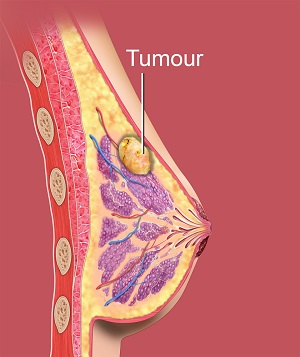
What is a Phyllodes Tumour?
Phyllodes tumour is a rare breast tumour that grows in the connective tissues (stroma) and ligaments that surround the blood vessels, lymph vessels, and ducts of the breast. The name Phyllodes is derived from the Greek language, which literally means “leaflike,” referring to the fact that the tumour cells develop in a leaf-like pattern.
Though the Phyllodes tumour is known to grow rapidly, it seldom spreads outside the breast. Most Phyllodes tumours (about 90 per cent) are benign (not cancerous) with some being malignant (cancerous) and the rest borderline (in between noncancerous and cancerous).
Who is at Risk of Developing a Phyllodes Tumour?
Phyllodes tumours are most common among women aged 40 to 50 (premenopausal women) and in women with benign breast lumps (known as fibroadenomas).
What are the Causes and Symptoms of Phyllodes Tumours?
The causes of a phyllodes tumour are currently unknown. The tumour typically occurs as people age. However, some of the factors attributed to the growth of a Phyllodes tumour include:
- Pregnancy
- Breastfeeding
- Injury
- Increased levels of the female hormone, estrogen
Phyllodes tumours tend to grow very quickly. A lump in the breast is the main symptom, which may occur over a few weeks to months. The lump feels smooth to the touch and the skin of the breast may appear red and warm. If the lump is left untreated, it may cause bulging in the breast and occasionally cause a sore on the breast.
How are Phyllodes Tumours Diagnosed?
Phyllodes tumours are quite difficult to diagnose as they appear similar to other breast lumps like fibroadenomas. However, you need to immediately see a doctor if you feel a lump during a self-breast examination. Your doctor will do a clinical breast examination to check the size and shape of the lump and recommend certain tests to confirm the presence of a Phyllodes tumour. Some of these tests include:
- Mammogram: Use of X-rays to develop pictures of the breasts
- MRI scan: Use of powerful magnets and radio waves to create cross-sectional pictures of the breasts
- Ultrasound: Use of sound waves to generate pictures of the breasts
- Biopsy: Removal of a piece of the tumour or the whole tumour through a hollow needle
How are Phyllodes Tumours Treated?
Even though most Phyllodes tumours are benign, they can grow rapidly and cause pain and other problems. To prevent this, your doctor will recommend having surgery to resect the tumour. Some of the treatments recommended to treat Phyllodes tumours include:
- Lumpectomy (removal of the tumour lump)
- Total mastectomy (removal of the whole breast)
Follow-up Treatments for Phyllodes Tumours
Since these tumours are known to recur, you should have regular follow-ups with your doctor after the treatment. Your doctor will inquire about your general health, examine your breasts and will arrange for any tests if deemed necessary. Sometimes, Phyllodes tumour can recur in the same area of your resected breast tissue. This risk is higher in the case of malignant tumours and further surgery is normally advised to treat the recurrent tumour. If surgery is not advisable, your doctor may use radiotherapy instead.
